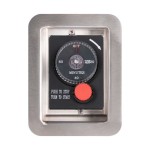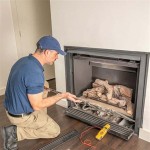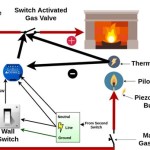Ventless Fireplace Gas Logs With Remote: A Comprehensive Guide
Ventless fireplace gas logs offer an attractive and convenient alternative to traditional wood-burning fireplaces. Their ability to operate without a chimney or flue makes them a versatile heating option for various living spaces. The inclusion of a remote control further enhances their user-friendliness, offering effortless operation and temperature management. This article will provide a comprehensive overview of ventless fireplace gas logs with remote, exploring their functionality, advantages, safety features, and maintenance requirements.
Ventless gas logs, also known as vent-free gas logs, are designed to burn cleanly and efficiently, minimizing the production of harmful emissions. They operate by using room air for combustion and converting nearly all the fuel into heat. This process ensures that the exhaust gases, primarily water vapor and carbon dioxide, are released into the room in minimal quantities. However, it is crucial to note that these systems require careful attention to proper installation and ventilation to maintain a safe and healthy indoor environment.
The remote control feature provides a significant advantage over traditional gas log sets. It allows users to adjust the flame height, temperature, and even turn the fireplace on or off from a distance. This convenience is particularly beneficial for individuals with mobility issues or those who prefer to control the fireplace without having to get up and manually adjust the settings. The remote control also often incorporates safety features like automatic shut-off timers and temperature sensors, enhancing the overall safety and reliability of the unit.
Understanding the Functionality and Components
A ventless gas log set with remote consists of several key components working together to produce a realistic and efficient fire. These components include the gas logs themselves, the burner assembly, the oxygen depletion sensor (ODS), the control valve, and the remote control unit.
The gas logs are typically crafted from ceramic or refractory cement, molded to resemble natural wood. These logs are strategically arranged over the burner to create a visually appealing flame pattern. The burner assembly is the core of the system, distributing the gas fuel evenly across the logs to produce a consistent and controlled flame. The burner design plays a crucial role in the efficiency and cleanliness of the combustion process.
The Oxygen Depletion Sensor (ODS) is a critical safety device that monitors the oxygen levels in the room. If the oxygen level drops below a pre-determined threshold, the ODS automatically shuts off the gas supply to the burner, preventing the accumulation of carbon monoxide. This feature is essential for ensuring the safety of the occupants and preventing potential health hazards.
The control valve regulates the flow of gas to the burner, allowing users to adjust the flame height and temperature. The remote control unit communicates with the control valve, enabling users to make these adjustments remotely. The remote control typically operates on radio frequency (RF) signals, providing a reliable and secure connection with the fireplace.
The installation process involves connecting the gas log set to a gas supply line, typically natural gas or propane, and positioning the logs on the burner assembly according to the manufacturer's instructions. Proper installation is crucial for ensuring safe and efficient operation. It is highly recommended to have a qualified professional install the gas logs to ensure compliance with all applicable codes and regulations.
Advantages of Ventless Fireplace Gas Logs with Remote
Ventless fireplace gas logs with remote offer numerous advantages over traditional wood-burning fireplaces and even ventless gas logs without remote capabilities. These advantages include ease of installation, improved energy efficiency, enhanced safety features, and increased convenience.
One of the primary advantages of ventless gas logs is their ease of installation. Unlike traditional fireplaces that require a chimney or flue, ventless gas logs can be installed in almost any room with a gas supply line. This flexibility makes them an attractive option for homeowners who want to add a fireplace to a room without incurring the cost and complexity of installing a chimney. The remote control eliminates the need for wall switches and complicated wiring, further simplifying the installation process.
Ventless gas logs are also more energy-efficient than traditional wood-burning fireplaces. They convert a higher percentage of fuel into heat, minimizing energy waste. This increased efficiency can translate into lower heating costs, particularly for homeowners who use the fireplace as a supplementary heating source. The remote control allows users to precisely control the flame height and temperature, optimizing energy consumption and preventing unnecessary heat output.
The safety features of ventless gas logs with remote are another significant advantage. The ODS, as previously described, is a critical safety device that prevents carbon monoxide poisoning. The remote control often includes additional safety features like automatic shut-off timers and temperature sensors, further enhancing the safety and reliability of the unit. These features provide peace of mind for homeowners and reduce the risk of accidents.
The remote control itself provides a significant increase in convenience. Users can easily adjust the flame height, temperature, and turn the fireplace on or off from a distance. This convenience is particularly beneficial for individuals with mobility issues or those who prefer to control the fireplace without having to get up and manually adjust the settings. The remote control also eliminates the need for bending down to access the control valves, making operation easier and more comfortable.
Safety Considerations and Maintenance
While ventless fireplace gas logs with remote offer numerous advantages, it is crucial to prioritize safety and perform regular maintenance to ensure optimal performance and longevity. Understanding the potential risks and implementing appropriate safety measures is essential for preventing accidents and maintaining a healthy indoor environment.
Proper ventilation is paramount when using ventless gas logs. Although they are designed to burn cleanly, they still produce small amounts of carbon dioxide and water vapor. Insufficient ventilation can lead to a buildup of these gases, potentially causing health problems. It is recommended to open a window or door slightly while the fireplace is in operation to ensure adequate air circulation. Following the manufacturer's instructions regarding room size and ventilation requirements is crucial.
Regular maintenance is also essential for ensuring the safe and efficient operation of the gas logs. This includes cleaning the burner assembly, inspecting the gas logs for damage, and checking the ODS for proper functionality. Dust and debris can accumulate on the burner assembly, affecting the flame pattern and reducing efficiency. The gas logs themselves can become cracked or chipped over time, potentially affecting their appearance and safety. A qualified technician should inspect the ODS periodically to ensure it is functioning correctly.
Carbon monoxide detectors should be installed in the home, particularly near the fireplace. These detectors provide an early warning of carbon monoxide buildup, allowing occupants to evacuate the premises and seek medical attention if necessary. Regularly testing the carbon monoxide detectors is crucial to ensure they are functioning properly.
It is also important to follow the manufacturer's instructions regarding the placement of flammable materials near the fireplace. Curtains, furniture, and other combustible items should be kept a safe distance from the fireplace to prevent fires. Children and pets should be supervised closely when the fireplace is in operation to prevent accidental burns.
The remote control should be stored in a safe place, away from children and pets. The batteries should be replaced regularly to ensure the remote control is functioning properly. If the remote control is not working, consult the manufacturer's instructions for troubleshooting tips. If the problem persists, contact a qualified technician for assistance.
By adhering to these safety guidelines and performing regular maintenance, homeowners can enjoy the warmth and ambiance of ventless fireplace gas logs with remote while minimizing the risk of accidents and health hazards. Selecting a reputable brand and having the system professionally installed further contributes to the overall safety and reliability of the unit. Regular inspection and professional servicing are recommended to ensure long-term safe and efficient operation.

Napoleon Gvfl30 Ventless Gas Log Set 30 Inch

Empire Driftwood Burncrete Ventless Gas Log Set Woodland Direct

Builders Series 30 Inch Vent Free Gas Log Set Remote Ready

White Mountain Ponderosa 24 Vent Free Gas Log Remote Ready Fine S

Empire Sassafras Ventless Gas Log Set With Variable Flame Control Option Fireplace Deals

18 C1c Original Chillbuster Vent Frees Gas Log Set

Outdoor Vent Free 42 Complete Gas Fireplace Stainless Steel With Remote Control Vre3200 Vre3242

Monessen Mountain Oak Ventless Gas Logs Millivolt Control Remote Ready 18 Inch Natural Double Yellow Flame Burner System And Heavy Grate Assembly

Pleasant Hearth Wildwood 18 Dual Fuel Vent Free Gas Log Set 30 000 Btu Com

Duluth Forge Ventless Dual Fuel Gas Log Set 18 In Stacked Red Oak Remote Control 210048 The Home Depot








